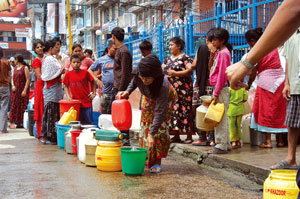 |
With the advent of monsoon, gastroenteritis (diarrhoea) outbreaks will follow. The communicable disease hospital in Teku will suddenly see an influx of patients. The vast majority of cases with diarrhoea are due to bacteria and not other causes like amoeba. However, most healthcare practitioners have amoeba so ingrained in our minds as the most common cause of diarrhoea in adults in Nepal that we treat for amoeba first. But acute diarrhoea which suddenly comes out of the blue (sometimes after a "bhoj") is almost never caused by amoeba.
Indeed most patients in Teku hospital with diarrhoea will admit to the abrupt onset of their disease, suggesting bacteria as the cause. So just obtaining a reliable patient history helps immensely in determining treatment as there are different medicines for bacterial diarrhoea versus ameoba diarrhoea.
As we have mentioned in these pages, using and drinking clean water are the keys to preventing diarrhoea in Nepal. Using soap to wash our hands also helps a great deal, even if the water that that flows from our taps is contaminated.
All the water sources (taps, wells, stone spouts) are unfortunately polluted, especially in urban centres like Kathmandu. In fact water from the venerated stone spouts seems to be the most polluted. And several times, Nepali scientists working in enteric illnesses have cultured the life-threatening cholera bacteria from water from the stone spouts in Kathmandu. When these scientists approached the local municipality with this scary information, the news was greeted with the usual Nepali nonchalance.
There is no choice but to drink boiled water. Drinking boiled water may not be practical for everyone due to lack of fuel or budget constraints. In that case, if someone is still motivated enough, chlorine tablets or liquid iodine can be used to obtain clean water.
Of course changing water pipes that run parallel with sewage pipes would help fix the age-old problem of water-borne diseases once and for all in Kathmandu. Perhaps all the donor money in the health sector for a year should be channeled into changing the water pipes in Kathmandu. If we had the political will to implement this policy, it would be the single most important and revolutionary public health measure carried out in Kathmandu. But at present the sad fact is that for many of us in Nepal, the land of the great Himalayas and bountiful rivers, just obtaining drinking water is hard enough.


